Article Highlights
Lapis Lazuli, a stunning celestial deep blue stone, has captivated humanity for millennia with its intense color and intriguing composition. This semi-precious stone, comprising deep blue lazurite, sparkly pyrite, and cloudy white calcite, holds significant cultural and historical importance. It’s known for its protective qualities and healing powers, earning it the title of “The Wisdom Stone.”
Geological Properties
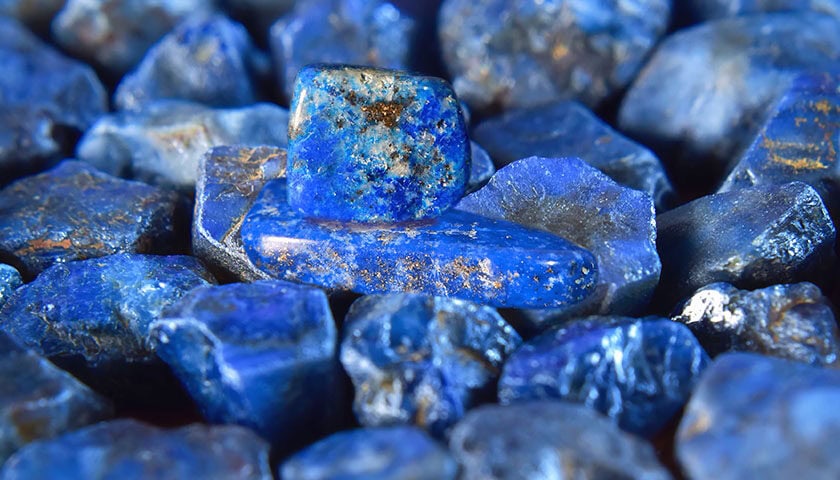
Composition and Formation
Lapis Lazuli is a rock rather than a mineral, primarily composed of lazurite, which imparts its rich blue color. This stone also contains pyrite, giving it a unique golden sparkle, and calcite, which appears as white patches. Formed through contact metamorphism, Lapis Lazuli is typically found in crystalline limestone deposits.
Locations and Mining
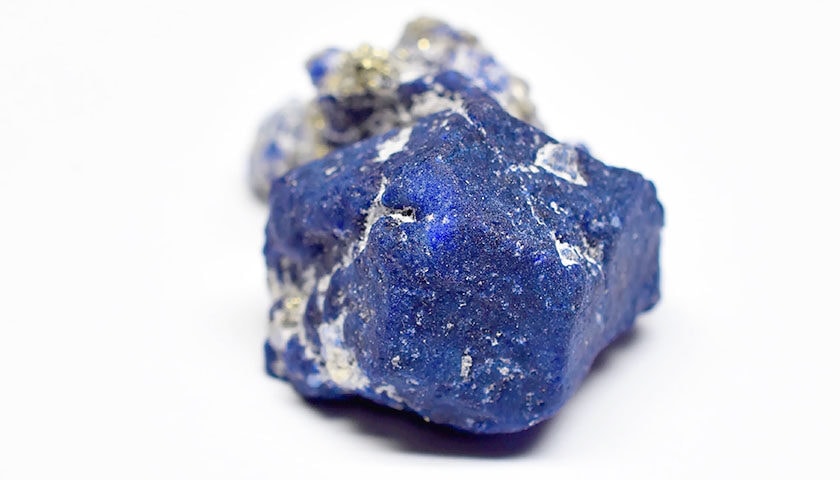
Historically, the most significant source of Lapis Lazuli has been the Sar-i Sang mines in Afghanistan. Other notable locations include Chile, Russia, and smaller deposits in the USA and Canada. The mining of Lapis Lazuli in these regions has a long and storied history.
Lapis Lazuli Meaning
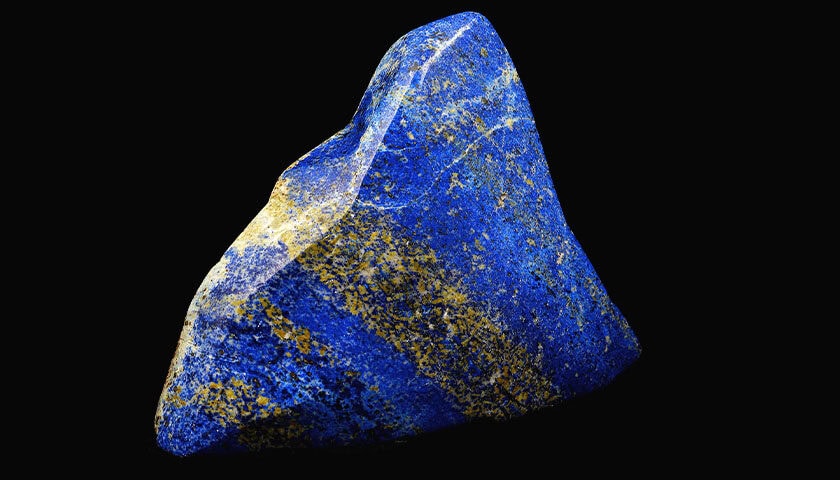
Ancient Civilizations
Lapis Lazuli was revered in ancient civilizations, including Egypt, Mesopotamia, Greece, and Rome. It symbolized truth, wisdom, and royalty. The Egyptians, in particular, used it for amulets, jewelry, and even ground it for eye shadow. Famous artifacts like the death mask of Tutankhamun highlight its historical importance.
Symbolism and Lore
Throughout history, Lapis Lazuli has been linked with power, wisdom, and truth. It was believed to offer protection from psychic attacks and foster deep peace and self-awareness.
History

Neolithic Beginnings and Ancient Trade
Lapis Lazuli’s journey begins in the Neolithic era, with its mining in Afghanistan. This precious stone was then exported across the Mediterranean and South Asia, tracing back to the ancient trade routes of the 7th millennium BC.
Archaeological Findings in Mesopotamia and Iran
Remarkable findings in Northern Mesopotamia’s settlements from the 4th millennium BC and at Shahr-e Sukhteh in Iran from the 3rd millennium BC showcase Lapis Lazuli’s historical significance. Royal Tombs in the Sumerian city-state of Ur have revealed daggers, bowls, and various ornaments adorned with Lapis Lazuli.
Lapis Lazuli in Ancient Mesopotamian Culture
The Akkadians, Assyrians, and Babylonians of ancient Mesopotamia extensively used Lapis Lazuli in their seals and jewelry. It is prominently mentioned in the Epic of Gilgamesh, dating back to the 17th–18th century BC. The Statue of Ebih-Il, a significant artifact from this era, features Lapis Lazuli inlays for the irises.
The Egyptian Era of Lapis Lazuli
In Egypt, Lapis Lazuli held a prestigious position, especially for crafting amulets and scarabs. The predynastic Naqada site reveals the use of Lapis Lazuli in jewelry. Additionally, Thutmose III’s temple carvings and Cleopatra’s use of powdered Lapis as eyeshadow highlight its royal significance.
Lapis Lazuli’s Influence in Mycenae and Beyond
The discovery of Lapis Lazuli jewelry in Mycenae speaks to the widespread use and trade connections with Egypt. Notably, Pliny the Elder’s description of the stone as “opaque with gold specks” underscores its historical and cultural value.
Lapis Lazuli: From Sapphire to Revered Stone
In late classical and medieval times, Lapis Lazuli was often confused with sapphire. Theophrastus’s description of “the sapphirus, speckled with gold,” aligns closely with Lapis Lazuli. This stone’s symbolic meaning evolved over time, gaining significance in Jewish and early Christian traditions.
Biblical References and Modern Understanding
Scholars now believe that many Old Testament references to sapphire, such as those in Exodus 24:10, were actually to Lapis Lazuli. Modern translations of the Bible have corrected these references, reflecting a more accurate historical understanding of the stone.
Healing and Metaphysical Properties

Physical Healing
Lapis Lazuli is believed to benefit the respiratory and nervous systems, reduce inflammation, and aid in vocal and thyroid issues. It’s also thought to boost the immune system and soothe skin irritations.
Emotional and Mental Healing
The stone is known for its calming effects, helping to alleviate stress, anger, and negative thoughts. It promotes self-awareness, clarity, and emotional balance, making it a valuable tool for psychological healing.
Spiritual and Metaphysical Aspects
In spiritual practices, Lapis Lazuli is said to open the Third Eye, enhancing intuition and psychic abilities. It’s also associated with the Throat Chakra, aiding in communication and self-expression.
Practical Uses of Lapis Lazuli
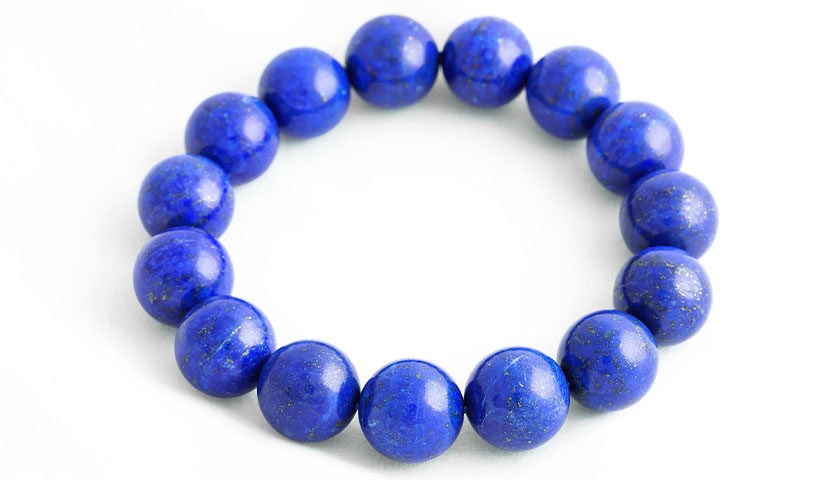
Jewelry and Adornments
Lapis Lazuli is popularly used in jewelry, such as necklaces, rings, and bracelets. Its deep blue hue, often with golden flecks of pyrite, makes it a visually striking gemstone.
Home Decor and Feng Shui
In home decoration, Lapis Lazuli is believed to bring positive energy and harmony. It’s often used in Feng Shui practices for balancing energies within a living space.
Meditation and Spiritual Practices
The stone is commonly used in meditation to enhance focus, inner truth, and spiritual awareness. Holding or placing Lapis Lazuli during meditation can reportedly amplify its benefits.
Care and Maintenance of Lapis Lazuli
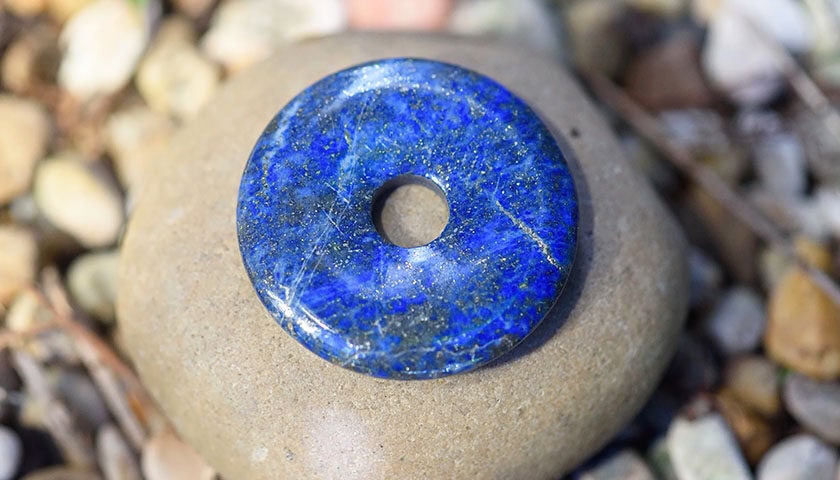
Cleaning and Handling
Lapis Lazuli should be handled with care due to its relative softness. It can be cleaned with mild soap and water but should be protected from harsh chemicals and prolonged exposure to direct sunlight.
Charging and Energizing
To maintain its metaphysical properties, Lapis Lazuli can be charged by moonlight or through meditation. It’s essential to periodically cleanse and recharge the stone to ensure its effectiveness.
Conclusion

Lapis Lazuli, with its deep historical roots and diverse properties, continues to be a stone of significance in various cultural, healing, and spiritual contexts. Its unique blend of beauty, lore, and perceived healing abilities makes it a timeless gemstone cherished across generations.



